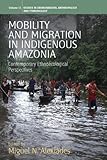Mobility and Migration in Indigenous Amazonia : Contemporary Ethnoecological Perspectives / ed. by Miguel N. Alexiades.
Material type: TextSeries: Environmental Anthropology and Ethnobiology ; 11Publisher: New York ; Oxford : Berghahn Books, [2009]Copyright date: ©2009Description: 1 online resource (304 p.)Content type:
TextSeries: Environmental Anthropology and Ethnobiology ; 11Publisher: New York ; Oxford : Berghahn Books, [2009]Copyright date: ©2009Description: 1 online resource (304 p.)Content type: - 9781845455637
- 9781845459079
- Biodiversity -- Amazon River Region
- Ethnoecology -- Amazon River Region
- Human geography -- Amazon River Region
- Indians of South America -- Ethnobotany -- Amazon River Region
- Indians of South America -- Amazon River Region -- Migrations
- Migration, Internal -- Amazon River Region
- SOCIAL SCIENCE / Anthropology / Cultural & Social
- Environmental Studies (General), Refugee and Migration Studies, Mobility Studies, Anthropology (General)
- 307.2089980811 23
- online - DeGruyter
| Item type | Current library | Call number | URL | Status | Notes | Barcode | |
|---|---|---|---|---|---|---|---|
 eBook
eBook
|
Biblioteca "Angelicum" Pont. Univ. S.Tommaso d'Aquino Nuvola online | online - DeGruyter (Browse shelf(Opens below)) | Online access | Not for loan (Accesso limitato) | Accesso per gli utenti autorizzati / Access for authorized users | (dgr)9781845459079 |
Frontmatter -- Contents -- List of Figures and Tables -- List of Contributors -- Editor’s Preface -- CHAPTER 1 Mobility and Migration in Indigenous Amazonia: Contemporary Ethnoecological Perspectives – an Introduction -- PART I CIRCULATIONS: MOBILITY, SUBSISTENCE AND THE ENVIRONMENT -- CHAPTER 2 Towards an Understanding of the Huaorani Ways of Knowing and Naming Plants -- CHAPTER 3 The Restless Life of the Nahua: Shaping People and Places in the Peruvian Amazon -- CHAPTER 4 Urban, Rural and In-between: Multi-sited Households Mobility and Resource Management in the Amazon Flood Plain -- CHAPTER 5 Unpicking ‘Community’ in Community Conservation: Implications of Changing Settlement Patterns and Individual Mobility for the Tamshiyacu Tahuayo Communal Reserve, Peru -- PART II TRANSFORMATIONS: KNOWLEDGE, IDENTITY, PLACE-MAKING AND THE DOMESTICATION OF NATURE -- CHAPTER 6 Domestication of Peach Palm (Bactris gasipaes): the Roles of Human Mobility and Migration -- CHAPTER 7 Intermediation, Ethnogenesis and Landscape Transformation at the Intersection of the Andes and the Amazon: the Historical Ecology of the Lecos of Apolo, Bolivia -- CHAPTER 8 The Political Ecology of Ethnic Frontiers and Relations among the Piaroa of the Middle Orinoco -- CHAPTER 9 ‘Ordenar El Pensamiento’: Place-Making and the Moral Management of Resources in a Multi- Ethnic Territory, Amazonas, Colombia -- CHAPTER 10 Plants ‘of the Ancestors’, Plants ‘of the Outsiders’: Ese Eja History, Migration and Medicinal Plants -- CHAPTER 11 Weaving Power: Displacement and the Dynamics of Basketry Knowledge amongst the Kaiabi in the Brazilian Amazon -- CHAPTER 12 Traditions in Transition: African Diaspora Ethnobotany in Lowland South America -- Index
restricted access online access with authorization star
http://purl.org/coar/access_right/c_16ec
Contrary to ingrained academic and public assumptions, wherein indigenous lowland South American societies are viewed as the product of historical emplacement and spatial stasis, there is widespread evidence to suggest that migration and displacement have been the norm, and not the exception. This original and thought-provoking collection of case studies examines some of the ways in which migration, and the concomitant processes of ecological and social change, have shaped and continue to shape human-environment relations in Amazonia. Drawing on a wide range of historical time frames (from pre-conquest times to the present) and ethnographic contexts, different chapters examine the complex and important links between migration and the classification, management, and domestication of plants and landscapes, as well as the incorporation and transformation of environmental knowledge, practices, ideologies and identities.
Mode of access: Internet via World Wide Web.
In English.
Description based on online resource; title from PDF title page (publisher's Web site, viewed 25. Jun 2024)


